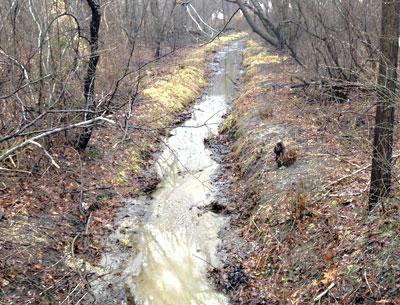Nature Notes: Swimming Upstream

We had six inches of rain Saturday and Sunday in Sag Harbor, a downer for the weekend crowd, a blessing for the alewives, frogs, and salamanders. Ligonee Brook is a longstanding stream that runs intermittently down through the last century and more. Its course has changed more than once and it only runs from Long Pond to Ligonee Cove to Sag Harbor Cove once every five years. Nonetheless, it is an important conduit for alewives and eels. Baby eels, or elvers, back from the Sargasso Sea, run up it in the spring to Long Pond to spend a few years growing up before running back down to saltwater and thence to the Sargasso Sea to spawn.
Eels are one of a very small number of catadromous fishes that go from fresh to saltwater to spawn. Alewives, on the other hand, are anadromous; they run up streams and rivers from the sea to spawn. Their ranks are swelled by a host of other fish — the Pacific salmons, the Atlantic salmon, shad, blue-back herring, striped bass, sturgeons, smelt, sea-run trout, and several others. Long Island has always had alewives but very few of the others.
While Big Fresh Pond in North Sea has perennially been the biggest spawning base for alewives on Long Island, several other ponds on the South Fork such as Long Pond, Scoy Pond in East Hampton’s Northwest, Stepping Stones Pond on the southwest edge of Lake Montauk, and Big Reed Pond east of the lake’s northwest shore, have all spawned alewives arriving by way of the Peconic Estuary from time to time. Hook Pond, Georgica Pond, Sagg Pond, and Mecox Bay have all contributed to alewife production in the past. Some of those that enter Sagg Pond each spring, if the inlet is not sanded over, make it all the way up to Jeremy’s Hole, a small kettle of freshwater in the northern quadrant of the Nature Conservancy’s Sagg Swamp Nature Preserve in Bridgehampton.
There is a major emphasis throughout the world’s estuaries on re-establishing these anadromous fish stocks, which have suffered greatly over the years, but especially in this center and the last. Dai Dayton and Friends of the Long Pond Greenbelt have been trying the hardest, it seems, when it comes to those using Ligonee Brook. In March of 2010 a good number of alewives made it all the way to Long Pond from Sag Harbor Cove to spawn. That run was helped by record mid-March rains, which totaled eight inches and more during a week’s time.
Most times, however, Ligonee is so waterless that the stream and its four culverts between its marine entrance and Long Pond are a challenge that alewives can’t overcome. They are stopped in the culvert under the Bridgehampton-Sag Harbor Turnpike, as Jean Held has observed in two fairly recent years, or clog the culvert and die at Brick Kiln Road where Southampton Town meets Sag Harbor Village, as they did in 2011. But isn’t that how evolution works? Survival of the fittest? Those that make it may give rise to generations that are a little better at going all the way up.
On Sunday, Dai and I by coincidence were observing different points along the length of the stream. She was at the Brick Kiln and turnpike culverts, while I was way upstream where Long Pond meets Ligonee. The six inches plus of rain certainly made a difference. For one thing, there was water in the streambed on the Long Pond side of the culvert under the turnpike, which has been dirt dry for more than a year. Secondly, water was overflowing the north end of Long Pond and entering the dried up Ligonee pond exit. The most promising observation, however, may have been made on Sunday by one of the Friends of the Long Pond Greenbelt, Dennis Kelley, who lives near the section of the stream between the turnpike and Brick Kiln Road. He observed a mature alewife swimming upstream.
Could this be a banner year? Maybe so, but we could use a little more rain upgradient.
Of course, in the long term, spawning probability could be greatly improved by cleaning out and/or replacing two of the culverts, those under the turnpike and Brick Kiln Road. The one under the old Bridgehampton to Sag Harbor railroad spur has already been replaced as part of Eagle Scout project with a handsome footbridge constructed by Max Yardley of Sag Harbor.
East Hampton Town has had a brand-new reinforced heavy duty box culvert, just the thing for alewives crossing, sitting in a Grimes work lot for four years now. It was intended for Alewife Brook Road, which crosses the Scoy run from Scoy Pond on its way downgradient to Elybrook Pond in Cedar Point County Park and from there out to Northwest Harbor. I have a dream that East Hampton will bequeath the culvert to Southampton Town to be used to replace either of the two failing ones in the Ligonee system. Then alewives will spawn annually in Long Pond and happily ever after!
Larry Penny can be reached via email at [email protected].
